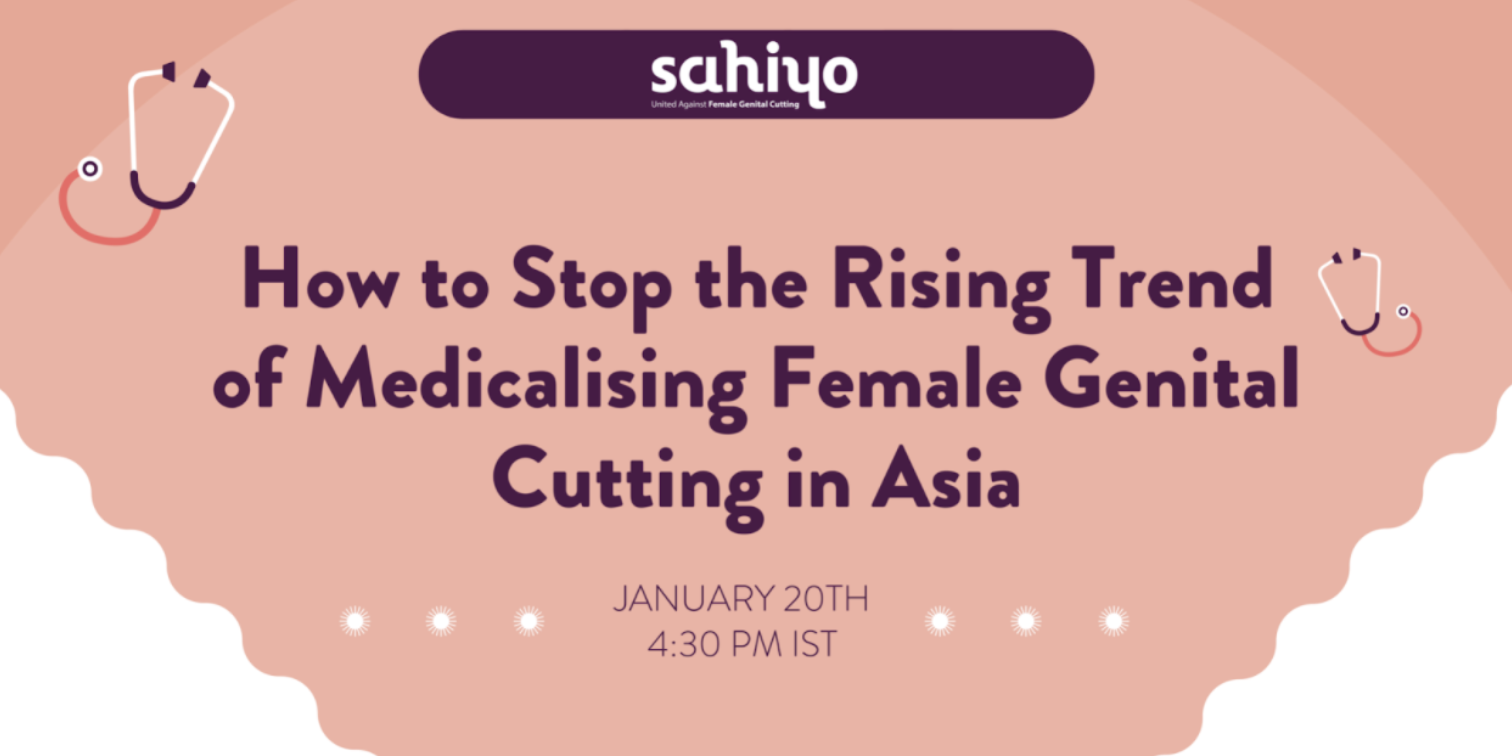On January 20th, Sahiyo hosted the webinar ‘How to Stop The Rising Trend of Medicalising Female Genital Cutting in Asia’. Organised by Sahiyo’s program’s intern Beth Fotheringham and moderated by Sahiyo co-founder, Insia Dariwala, the webinar featured a panel of experts in female sexual and reproductive health: Saza Faradilla, Kalpana Swaminathan, Ibu Atas, and Dr. Nozer Sheriar. The discussion was centred around two main questions: Why does the medicalisation of female genital cutting need to be stopped and how can we stop this rising trend?
Sahiyo Intern Beth began the event by providing a brief overview of female genital cutting (FGC), citing motivating factors for the practice such as social acceptance, marriageability, community belonging, proof of virginity, curbing promiscuity, hygiene, and religion. Though there are no health benefits to medicalised FGC, there is often a misguided belief that the procedure is safer when medicalised. The medicalisation of FGC refers to situations in which FGC is practised by a healthcare professional, whether in a public or a private clinic, at home or elsewhere. More than 200 million women and girls have experienced some form of FGC, with 1 in 3 girls being cut by a health professional.
The following video shared during the webinar highlights that many young girls undergo this practice against their will.
By courageously sharing her voice and her story, Saza Faradilla gives us an insight into how the practice is carried out without consent. Her story showcases the trauma experienced by survivors who only discover that they have suffered FGC as an adult. This speaks to the aura of silence that surrounds the practice. A lack of questioning falsely leads people to believe that FGC is necessary for socio-cultural or religious reasons. In Singapore 20.5% of doctors carry out FGC, 9.4% of which perform FGC on girls before their first birthday. The preferred age for cutting is between 4-6 months.
The backlash Saza receives in her community highlights the need for change. By speaking out against what is perceived to be normal in her community, she recognises that her right to health, the right to physical integrity, and the right to equality and non-discrimination have been violated. Saza’s heartfelt and inspiring activism demonstrates that human rights emerge and evolve through the attempts of ordinary people to challenge injustice. Saza embodies the power of storytelling by sharing stories; hearing a survivor’s experience can definitely shift attitudes and opinions on this issue.
The significant lack of information surrounding FGC and medicalization is driving the practice. This means that individuals, including doctors, conform to the norm of FGC without being aware of its inequalities. Pressure to conform to social expectations is a motive behind why healthcare professionals perform FGC. Carrying out FGC in hospital or health settings creates a false sense that FGC is necessary. FGC does not take the bodily integrity of the child into consideration and there is a misogynistic link to FGC being medicalised. Portraying that cutting can be done ‘cleanly, neatly and safely’ directly translates into control of female sexuality and results in the subordination of women. Kalpana expressed how FGC injures much more than the child’s anatomy - any child that suffers unwanted touch will deal with a myriad of mental and psychological effects. However, Kalpana notes that this trauma can also translate into a determination in survivors to fight back and speak out against the wrong-doing they have suffered.
Kalpana Swaminathan further develops the argument against the medicalisation of FGC, stating that there is no room for the medicalisation of FGC and the practice cannot be condoned. She explains how the power of culture and tradition can make individuals think and act collectively. Therefore, changing the attitudes of parents and doctors is integral in the campaign to eradicate FGC.
How can we stop this rising trend?
FGC is not only happening in Asian communities, it is happening everywhere in the world. Sahiyo co-founder Insia Dariwala raised pressing questions such as how do we hold doctors responsible and who is going to do it? Ibu Atas, long standing activist for FGC in Indonesia explains that a firm stance is needed in the work against this practice. FGC is deeply embedded in culture. By campaigning against this practice, we are challenging community attitudes, social norms and their values. Taking immediate action is the best response to the rising trend of medicalising FGC.
The message I took away from this webinar ties in with Sahiyo’s objective to recognise and emphasise the values of consent, as well as a child and woman’s right over her own body. Our speakers stressed that there are no justifications for FGC, regardless of who carries it out. Kalpana explains that parental attitudes are influenced by social norms and refers to consent as ‘a can of worms.’ This made me realise that understanding how parental attitudes influence the practice of FGC is key to developing appropriate interventions aimed at eradicating this practice. As put by Ibu Atas, the message must be clear: ‘Don’t touch our genitals.’ Every female should have the right to make autonomous decisions about her own body and reproductive functions. This right is at the core of her basic human rights.
Sahiyo would like to thank our panelists for bringing their thought-provoking perspectives to this discussion. You can learn more about the esteemed speakers here.
Watch the full event here:

